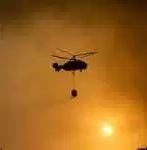Forest Service tries a different approach on whether to let fires burn
Posted: February 2, 2017Source: NPR

IMAGE BY TOM WADDELL / FOREST BUSINESSNETWORK
Scientists say more low-intensity wildfires are needed to clear out overgrown forests to help prevent bigger fires. Deciding where and when to let fires burn is tricky.
DAVID GREENE, HOST:
Dangerous wildfires made a lot of news across this country last year. But there are scientists who say we need more fires, low-intensity ones that clear out overgrown forests and help prevent the bigger fires. Deciding where and when to let fires burn is tricky, and so the U.S. Forest Service is working on a new approach. From member station KQED in San Francisco, Lauren Sommer reports.
LAUREN SOMMER, BYLINE: In early September, as a thunderstorm rolled over the Sierra Nevada, lightning hit a tree, and it started to burn.
SARAH LAPLANTE: The fire was really small at that point. It was probably about a quarter of an acre.
SOMMER: Sarah LaPlante was the ranger on duty at the Sierra National Forest south of Yosemite. The fire was spreading, and she had to decide what to do.
LAPLANTE: So we didn’t put firefighters right on the line trying to stop the fire right where the fire is. We can actually let the fire burn in a controlled way.
SOMMER: Let the fire burn – not what we heard from Smokey Bear.
(SOUNDBITE OF ARCHIVED RECORDING)
SAM ELLIOTT: (As Smokey Bear) Yes. Let a little fire get started, catch on, destroy and your forest is nothing.
(SOUNDBITE OF MUSIC)
SOMMER: But, LaPlante says, fire can be good. Sierra Nevada forests actually need it so they don’t get too dense or overgrown. And since this fire was miles from any town, she let it spread, keeping a close watch.
LAPLANTE: It wasn’t torching trees. It was just cleaning up the forest floor, getting rid of all of that over-accumulation of dead, woody debris.
SOMMER: It’s exactly what LaPlante wanted to see. But her decision to let the fire burn is pretty rare because it’s a tough call to make.
LAPLANTE: It’s something that you take really seriously, and there is some level of, you know, nerves.
SOMMER: And sometimes, very rarely, these decisions go wrong.
(SOUNDBITE OF NEWS REPORT)
UNIDENTIFIED REPORTER: Officials answering questions about a wildfire that got out of control in Lassen National Park…
SOMMER: Four years ago, rangers let a fire burn in Lassen Volcanic National Park in far-northern California. But the wind picked up, and the fire spread towards the community of Old Station. John Wallace, who ran a restaurant there, got ready to evacuate.
JOHN WALLACE: The smoke was so heavy here because it was blowing in our direction. It was a scary situation, yeah.
SOMMER: Luckily, the town was spared. But residents were angry.
WALLACE: Just the fact that they let it burn and get away from them. Yeah, I mean, any something affects you that way, I mean, people get upset.
SOMMER: Near disasters like that make forest managers hesitant to let any fire burn. And that makes it hard to change the legacy of Smokey Bear, says Alan Taylor, a fire planner with the U.S. Forest Service.
ALAN TAYLOR: We have a better understanding of the role of fire now as an agency and probably, you know, as a society.
SOMMER: So the Forest Service is piloting a new approach to fire in three national forests in California. The agency is using computer models to create fire-risk zones. Some zones, near towns and roads, are protected. Fires there would be put out. But in another zone, on about 40 percent of the land, Taylor says rangers would have to answer this question.
TAYLOR: If it’s a lightning-caused fire, why are we putting it out?
SOMMER: This flips the script. Before, rangers had to make the case to let it burn. But now they’d have to justify putting a fire out if there’s no danger to people or homes.
Now, there’s a downside. More fire means more smoke, and California’s Central Valley already has some of the worst air quality in the country.
TAYLOR: It probably will be smokier at times than what we’re used to, but the fires are coming one way or the other. If we keep putting them out and the fuels keep growing, eventually it gets to the point where you can’t put it out.
SOMMER: Californians will have to get more comfortable with smaller fires, Taylor says, in order to prevent catastrophic fires. If this new approach helps do that, it could be adopted by other forests across the West. For NPR News, I’m Lauren Sommer in San Francisco.
(SOUNDBITE OF ALUCIDNATION SONG, “THE INFINITE VARIETY”)
